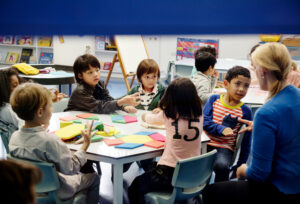Calculating the percentage of marks is a fundamental skill that every school student should master. It is not only useful for tracking academic performance but also serves as an essential tool for setting goals, identifying areas for improvement, and meeting eligibility criteria for future opportunities. This guide will help you understand the step-by-step process of calculating percentages, ensuring that you get it right every time.
Understanding how to compute percentages is critical in academics because schools, colleges, and various competitive exams use them to evaluate and compare students. Knowing your percentage allows you to measure your performance accurately and provides clarity about where you stand in relation to your peers. This article will simplify the process and provide examples to make it easier for you to understand and apply.
What Does Percentage Mean?
The term “percentage” is derived from the Latin word “per centum,” meaning “per hundred.” It expresses a value as a fraction of 100, making it easier to compare data. In the context of marks, percentages help determine how much of the total marks you have secured.
For instance, if you score 80 out of 100 in a test, your percentage is 80%. Similarly, if the total marks for an exam are 500, and you score 400, your percentage is 80% as well. The concept of percentage makes it easy to understand and evaluate scores across different subjects and exams.
The Formula for Calculating Percentage
The formula for calculating percentage is simple and universal:
Percentage=(Obtained MarksTotal Marks)×100\text{Percentage} = \left( \frac{\text{Obtained Marks}}{\text{Total Marks}} \right) \times 100Percentage=(Total MarksObtained Marks)×100
Here:
- Obtained Marks refers to the marks you have scored in an exam.
- Total Marks indicates the maximum marks for the exam.
- The result is multiplied by 100 to convert the fraction into a percentage.
Using this formula, you can calculate the percentage for a single subject or for multiple subjects combined.
Steps to Calculate Percentage
Calculating percentages involves a few straightforward steps:
- Collect Your Scores: Start by gathering the marks you obtained and the total marks for each subject. Make sure the data is accurate to avoid errors.
- Sum Up the Marks: If you are calculating the percentage for multiple subjects, add up all the marks you obtained in those subjects. Similarly, add up the total marks for all the subjects.
- Apply the Formula: Divide the total obtained marks by the total marks and multiply the result by 100. This will give you your percentage.
For instance, let’s assume you scored 85 in Mathematics, 78 in Science, and 92 in English, each out of 100. The total obtained marks would be 85 + 78 + 92 = 255, and the total marks would be 300. Using the formula:
Percentage=(255300)×100=85%\text{Percentage} = \left( \frac{255}{300} \right) \times 100 = 85\%Percentage=(300255)×100=85%
This means your overall percentage is 85%.
Why Is Calculating Percentage Important?
Understanding and calculating percentages are crucial for several reasons. First, they provide a standard measure of academic performance, allowing students to compare their results across different subjects and terms. Percentages are also vital for determining eligibility for scholarships, admissions, and other academic opportunities.
Moreover, percentages are motivational. They allow students to track their progress over time, identify weak areas, and work towards improving their scores. For example, if a student’s percentage improves from 70% to 80% over two terms, it reflects both effort and growth.
Practical Example of Percentage Calculation
Let’s dive into another example to make the process even clearer. Suppose a student appears for five subjects with the following scores:
- Mathematics: 90/100
- Science: 88/100
- English: 84/100
- History: 76/100
- Geography: 82/100
Step 1: Add the Obtained Marks
90 + 88 + 84 + 76 + 82 = 420
Step 2: Add the Total Marks
Since each subject is out of 100, the total marks are 100 × 5 = 500
Step 3: Apply the Formula
Percentage=(420500)×100=84%\text{Percentage} = \left( \frac{420}{500} \right) \times 100 = 84\%Percentage=(500420)×100=84%
In this case, the student’s overall percentage is 84%.
Common Challenges Students Face
Many students struggle with calculating percentages accurately, especially when dealing with decimals or weightage-based marks. Forgetting to include all subjects in the total or making errors while summing up marks are common mistakes. Another challenge arises when calculating percentages for exams with varying weightages for different sections.
For example, some exams allocate different percentages to multiple-choice questions, essays, and practicals. In such cases, students need to multiply their scores by the weightage percentage and then calculate the total.
Tips for Accurate Percentage Calculation
Accuracy in percentage calculation is vital for students. Here are a few tips to ensure your calculations are correct:
- Double-Check Your Totals: Ensure that both obtained marks and total marks are summed up accurately.
- Use a Calculator: For complex calculations, using a calculator can reduce the chances of errors.
- Break Down the Process: If the total marks are large, break down the calculation into smaller steps to avoid confusion.
- Practice Regularly: The more you practice, the better you become at calculating percentages quickly and accurately.
Applications of Percentages in Real Life
While percentages are essential for academics, their applications extend far beyond school. In daily life, percentages are used to calculate discounts, interest rates, tax amounts, and even health metrics like body fat percentages. Mastering this skill early on can be immensely beneficial for students in their personal and professional lives.
For example, when you see a 20% discount on a product priced at ₹1,000, calculating the discounted price involves finding 20% of ₹1,000 (₹200) and subtracting it from the total (₹800).
Conclusion
Calculating the percentage of marks is a straightforward yet vital skill for school students. It allows you to track your academic performance, set goals, and stay motivated. By following the steps outlined in this guide and practicing regularly, you can calculate percentages accurately and confidently. Remember, percentages are not just about academics—they are a life skill that will benefit you in various aspects of life.
FAQs
For weightage-based exams, multiply the marks obtained in each section by its weightage. Add the results and divide by 100. For example, if a test has a 70% theory and 30% practical component, calculate each part separately and then combine them.
For smaller numbers, you can calculate percentages mentally by breaking them down. For example, to find 20% of 50, calculate 10% (5) and double it (10).
Yes, include the deducted marks in your obtained marks. For example, if you scored 50 but lost 5 marks due to negative marking, use 45 as your obtained marks.







